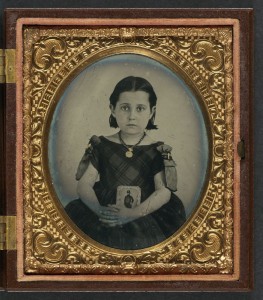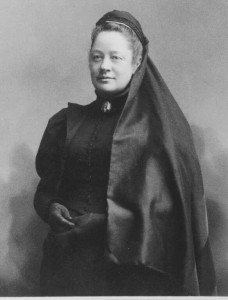 By Karen Abbott (Regular Contributor)
By Karen Abbott (Regular Contributor)
Nearly 700,000 men died in the Civil War, more from disease than from battlefield wounds (“bowels are of more consequence than brains” was a common jest”) and these fatalities ultimately belonged to those left behind; it was the survivors who had to contend with the business of burying and grieving. The scale of the carnage demanded a strict set of social rituals, a culture of mourning in which the literal embodiment of death was considered the best way to accept it.
For women this meant stocking their armoires with “mourning” fashion, which was more readily available in the North even though its death rate was one third of that of the Confederacy. In the spring of 1863, down on Ladies’ Mile, Lord & Taylor opened a “mourning store” where new widows could dress their grief fashionably, selecting from a variety of now-esoteric fabrics: Black Crape Grenadines, Black Balzerines, Black Baryadere Bareges, Black Bareges, Mourning Silks, Lawns, Chintzes, Alpacas, Barege
Shawls, and Grenadine Veils. Godey’s Lady’s Book, the mid-19th century’s answer to Vogue, regularly printed drawings of bonnets, collars, sleeves, breakfast caps and a variety of mourning dresses for all occasions.
 Mourning attire evolved over a period of stages, growing progressively less stringent. “Deep” or “heavy” mourning required a widow to wear all black dress and accessories, including a heavy black crepe veil. Jewelry was verboten unless it was made of polished coal, a lock of hair of the deceased, or a small picture of the deceased. Next came full mourning, during which her black dress and veil could be accented by lighter shades of lace and cuffs. The final stage, half mourning, allowed shades of lavender and gray; Godey’s recommended a black silk and French grenadine ensemble topped off with a Leghorn hat, trimmed with black velvet and black plume.
Mourning attire evolved over a period of stages, growing progressively less stringent. “Deep” or “heavy” mourning required a widow to wear all black dress and accessories, including a heavy black crepe veil. Jewelry was verboten unless it was made of polished coal, a lock of hair of the deceased, or a small picture of the deceased. Next came full mourning, during which her black dress and veil could be accented by lighter shades of lace and cuffs. The final stage, half mourning, allowed shades of lavender and gray; Godey’s recommended a black silk and French grenadine ensemble topped off with a Leghorn hat, trimmed with black velvet and black plume.
For a widow, the entire public grieving process lasted a minimum of two and a half years, although after April 1865 Mary Todd Lincoln spent the rest of her days swaddled in black. She was too distraught to appear at her husband’s funeral but later recorded her grief in a private letter to a friend: “Time brings so little consolation to me and do you wonder when you remember whose loss. I mourn over that of my worshipped husband, in whose devoted love, I was so blessed, and from whom I was so cruelly torn. The hope of our reunion in a happier world than this, has alone supported me, during the last four weary years.” When she died in Springfield in 1882, her body was laid out in the parlor of her sister’s home—in the exact spot where, 40 years before, she had stood as a bride.
Karen Abbott is the author of Sin in the Second City and American Rose, both New York Times bestsellers. She is a featured contributor to Smithsonian magazine’s history blog, Past Imperfect, and also writes for Disunion, the acclaimed New York Times series about the Civil War. She’s at work on her next book, a true story of four Civil War spies who risked everything for their cause. Find her online at www.karenabbott.net or @KarenAbbott on twitter.
This post first appeared at Wonders & Marvels on 23 July 2012.
References:
Drew Gilpin Faust, This Republic of Suffering. New York: Alfred A. Knopf, 2008.
Dorothy Denneen Volo and James M. Volo. Daily Life in Civil War America. Westport, CT: Greenwood Press, 1998.
“Sealed With Sorrow.” New York Times, September 9, 1999.
Images:
Young girl mourning her cavalry father (Library of Congress)
Woman in mourning dress and jewelry (Library of Congress)
